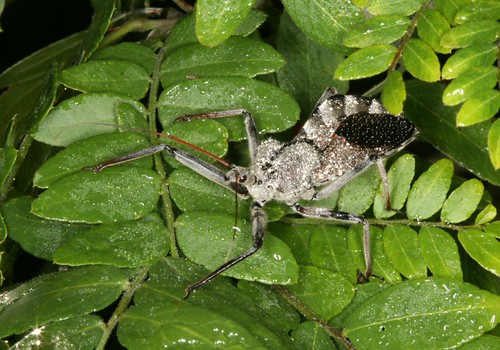tags: Wheel Bug, Arilus cristatus, Image of the Day
Wheel Bug, Arilus cristatus, a late-instar nymph.
[Here are a couple pictures of] the Wheel Bug, also taken in the last week. The critter (a member of the Assassin Bug family, Reduviidae) is named for the gear-wheel structure on its thorax; only the adults have this structure (see adult, below the fold). That nasty-looking beak, which is more visible on the image of a late-instar nymph can inflict significant damage if it pokes you. I have never been bitten, but descriptions of the bite include "ten times worse than a hornet sting" and "painful and long-lasting". In the early fall here you can see them flying around like slow-moving dirigibles; very awkward but they eventually get where they are headed.
Image: David A. Rintoul, KSU [larger]
More information and adult image below the fold ..
Wheel Bugs are True Bugs (Hemiptera), which is an order that includes such diverse insects as Stink Bugs, Water Striders, and Bed Bugs. Although the generic term "bug" is bestowed on all sorts of insects, it is scientifically accurate only when applied to True Bugs. The wheel bug is one of the largest members of the Reduviidae, that family of insects otherwise known as "assassin bugs".
Hemipterans have two pairs of wings. The front half of the anterior pair is leathery and the back half is shiny and membranous like that of a fly or bee. The hindwings are completely membranous. Another characteristic of Hemiptera are their mouthparts, which form a long, narrow beak that extends posteriorly beneath the body. The outer segmented portion of the beak protects two mandibles and two maxillae -- all used to pierce the bug's food items -- and serves both as a straw for depositing saliva into its prey and sucking the victim's resulting body fluids out.
The Wheel Bug has some of the best-developed mouthparts of the True Bugs. Its formidable beak arises at the anterior end of its long tubular head and unfolds forward. When it encounters a prey item -- usually an adult insect or caterpillar -- it lunges forward, grabs the insect with its front legs, and buries its hypodermic beak into the body of the hapless victim. The Wheel Bug then injects enzyme-laden saliva -- which immobilizes the prey within 30 seconds and digests its insides into syrup -- after which the Wheel Bug sucks out all the victim's bodily fluids. Because they eat harmful insects, Wheel Bugs are allies of man, but they can and will inflict a painful bite if handled.
- Log in to post comments




Assassin bugs are important characters in "Pest Control" by Bill Fitzhugh. If you are interested, put it on your amazon wishlist and I'll get it for you.
I've a "pet" wheel bug who likes to hang around here sucking on the june bugs who gather around the porch light (which I leave on for him, the tree frogs and the toads).
But there's another more interesting critter I've yet to ID which (can) feeds on wasps. It looks alot like a mosquito, but it's not what we call mosquito hawks, or crane fly. It's a bit smaller and its wings when not in use, lay upon its thorax.
got bit by one of these and it was very painful and took several wks to heal......
would like to know though , if these are the assassins that carry chagas disease?
anyone know? would be helpful to know this esp if i need to get tested down the line.